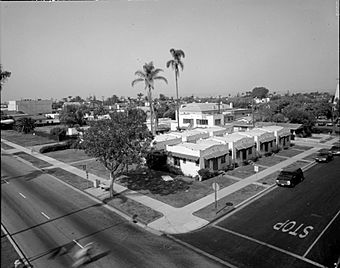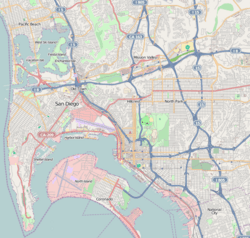Heilman Villas facts for kids
Quick facts for kids |
|
|
Heilman Villas
|
|

Heilman Villas in Coronado, Calif.
|
|
| Location | 1060, 1070, 1080, 1090 Seventh St. and 706--720 (even nos.) Orange Ave., Coronado, California |
|---|---|
| Area | 4 acres (1.6 ha) |
| Built | 1922 |
| Architect | Robert Hellman |
| Architectural style | Mission/Spanish Revival, Spanish Colonial Revival |
| NRHP reference No. | 92000319 |
| Added to NRHP | April 08, 1992 |
The Heilman Villas were a special group of buildings in Coronado, California. They were found at the corner of Seventh Street and Orange Avenue. This property had 10 separate small houses called bungalows. It also had one two-story building with two homes inside, known as a duplex. Six of the bungalows and the duplex faced a central outdoor area. This area opened onto Orange Avenue. The other four bungalows faced Seventh Street.
Contents
The History of Heilman Villas
The Heilman Villas were built in 1922. They were made for Robert and Lillian Heilman. Over the years, the complex had different names.
Changing Names Over Time
First, it was known as Heilman Villas. Later, people called it DeCoby Court. After that, it became Hollander Court. In 1952, the buildings changed again. They became a place for travelers to stay, called the Coromar Motel.
City Ownership and New Purpose
In 1973, the City of Coronado bought the entire property. Community groups started using the buildings. These groups included the Chamber of Commerce. The Coronado Historical Association also used the space. The City decided to give the complex a new name. They called it Babcock Court. This name honored Elisha S. Babcock. He was one of the people who helped start the City of Coronado.
A Special Place in History
The Heilman Villas were recognized as important in 1992. They were added to the National Register of Historic Places. This is a list of places in the United States that are worth saving. They are important because of their history or special design.
Why They Are Historic
The villas are good examples of bungalow court architecture from the 1920s. They were built in the Mission Revival style. This style uses elements from old Spanish missions. Inside, the homes had special features. They included hardwood floors. They also had leaded glass, which is glass with patterns made by lead strips. These details showed the Craftsman style.
Where Heilman Villas Once Stood
Today, the Heilman Villas are no longer there. The Coronado Police Department now stands on the land where they used to be.
See also
 In Spanish: Heilman Villas para niños
In Spanish: Heilman Villas para niños





